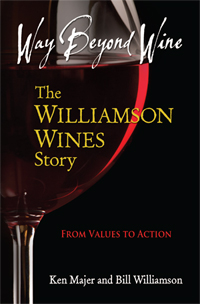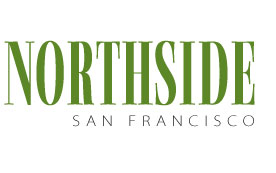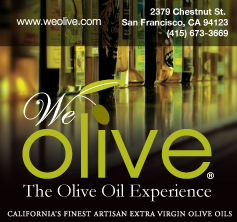 Sonoma County vintner Bill Williamson discusses a special Chardonnay vineyard in Chapter 6, “The Little Chardonnay that Never Should Have Been.”
Sonoma County vintner Bill Williamson discusses a special Chardonnay vineyard in Chapter 6, “The Little Chardonnay that Never Should Have Been.”
The sun, the cool, the dry, and the wet/Made this Chardonnay a very good bet
I believe that genius is the art of taking infinite pains to do something right. Basically, you visualize and create something, you innovate, and with a lot of hard work, you achieve success. When someone comes along, looks at the end result, and says, “That’s genius!” you know it’s really a matter of relentless creativity and effort. Sometimes genius is serendipitous or maybe it’s just dumb luck. In the case of our Chardonnay, genius was a matter of the heart.
In 1983 the U.S. Army Corps of Engineers built Warm Springs Dam, which forms Lake Sonoma and is about five miles from our vineyard. The compacted, earth-fill dam serves as a deterrent to disastrous floods and stores water for irrigation. The beautiful lake is also used for recreation.
A fish hatchery was built at the bottom of the dam to replace and enhance the spawning grounds for salmon and steelhead trout. Water is constantly released from the dam into the river, Dry Creek, to maintain the water level so the fish can swim to sea and come back to spawn. Constantly full, the river conveniently makes a curve around our vineyard. Before we bought the property, our Chardonnay and Merlot varietals had been planted halfway between the river and the hill line.
The water in the river is mind-numbingly cold. In fact, as the warm summer winds blow across the cold water, they create a microclimate for the Chardonnay vines that are closest to the river. Today, if you stand at the end of one of the vineyard rows in just the right spot, you can feel the two climates. Facing south and stretching your arms forward, your right hand will remain cool, and your left hand will get warm.
The heat was a problem for our Chardonnay vines. It gets so hot in the center of the valley away from the river that the vines were getting scorched. Because Chardonnay prefers cooler temperatures and more moisture than other varietals, we decided to remove the Chardonnay vines and replace them with Cabernet Sauvignon grapes. Removing an existing vineyard is a big job, so our decision reflects the intensity of the sun’s midsummer rays in Dry Creek Valley.
We hired a driver with a Caterpillar D9. The tractor had a huge blade affixed to the front, which was controlled by hydraulic arms, and a ripper attached to the back to tear up the soil—and anything else that got in the way—as far down as six feet.
The driver, José, deftly handled the monstrous machine as I watched with some reluctance from 20 feet away. Pulling out fruit-producing, living vines is tough for a farmer to watch. I had pangs of remorse as I realized it would take 7 to 10 years to return this plot of land to a mature vineyard.
The root systems for grapevines have a unique characteristic: They fan out underground, but they will not impose their need on the root system of a neighboring vine. When they come in contact with other grapevine roots, they don’t entwine; instead, they turn away. The roots for each plant grow deeper, but not wider.
As José and the Cat uprooted these maturing Chardonnay vines, they lay upside down on the ground, exposing root fans that gave the appearance of candelabras in the sunlight. That did it for me. Call me emotional, but something said it was just wrong to destroy these beautiful vines. I had pangs of remorse and, in a decision of the moment, in an act of pure intuition, I ran over to stop José.
“What’s up, Mr. Williamson?” José said, a little disconcerted at the interruption. “I’m on a roll here.”
“Can’t do it, José,” I said. “These vines are just too beautiful to destroy completely. Tell you what. Let’s leave the last 10 rows of vines nearest the river. It’s cooler there, and I have the feeling those vines will do just fine.”
That decision resulted in our one small area of Chardonnay planted contiguously to our Cabernet Sauvignon.
The year after replanting the vineyard, we decided to plant olive trees at the end of every second row of new Cabernet vines as well as the remaining Chardonnay. We chose trees from Nan McEvoy, a true California pioneer, who imports her trees from Tuscany and grows them along with many other wonderful fruit trees on her Petaluma ranch.
We planted all the olive trees on the same day, and they all share the same drip-irrigation line. Tuscan olives love the heat. Today those next to the Cabernet are twice the size of those next to the Chardonnay. This is dramatic evidence of how climate and microclimate nuances on the same acreage can affect the growth of plantings. The subtleties are not lost on the fruit. Our Chardonnay grapes are outstanding, partly because we paid attention to the cooling effect of the river and avoided the heat of the sun in the area just 50 yards away.
During the past few years that we have produced our Amourette Chardonnay from this vineyard, the wine has performed superbly in competition, winning gold medals at the prestigious San Francisco Chronicle Wine Competition and the Sonoma County Harvest Fair Wine Competition. Because Sonoma County is home to some of the best Chardonnays in the country, we can rest comfortably knowing that our little Chardonnay that never should have been now ranks among the finest in the country.
Years later I’m still getting credit for the decision not to rip out all of the Chardonnay vines. The credit is little deserved. My decision was simply a matter of the heart, inspired by a voice from somewhere outside of my rational mind that whispered, keep 10 rows of Chardonnay next to Dry Creek!
Way Beyond Wine: The Williamson Wines Story: By Ken Majer and Bill Williamson is scheduled for release in December 2009, www.waybeyondwine.com.













